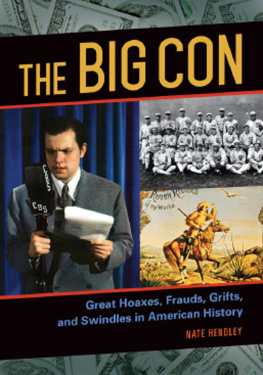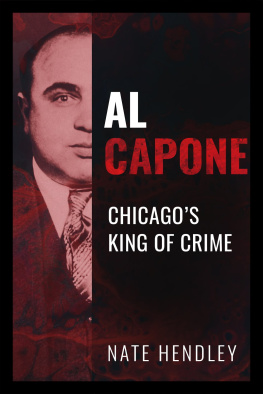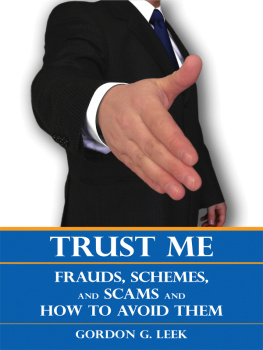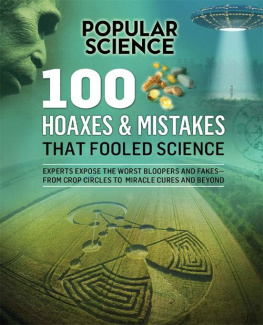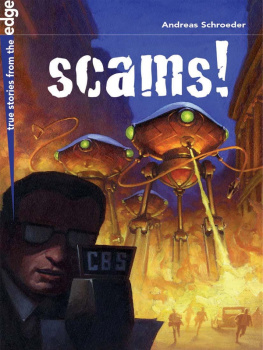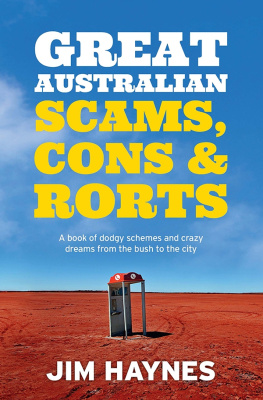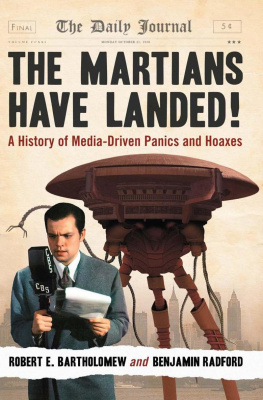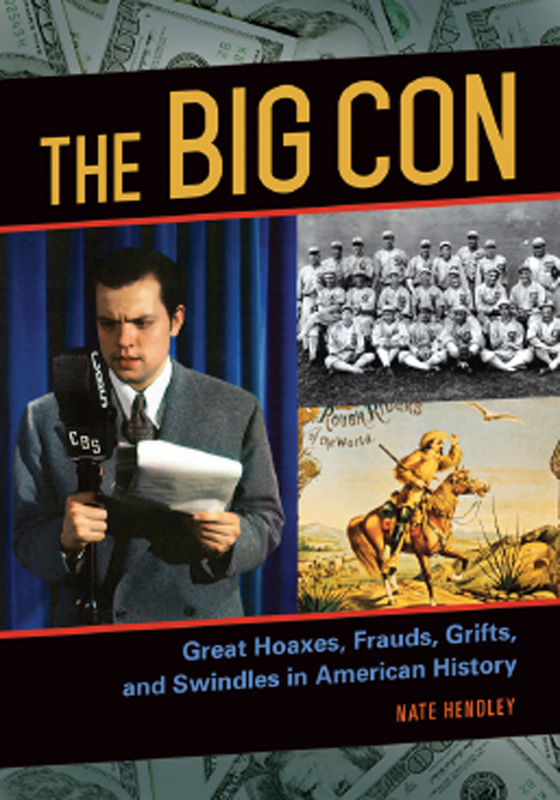THE BIG CON
Copyright 2016 by ABC-CLIO, LLC
All rights reserved. No part of this publication may be reproduced, stored in a retrieval system, or transmitted, in any form or by any means, electronic, mechanical, photocopying, recording, or otherwise, except for the inclusion of brief quotations in a review, without prior permission in writing from the publisher.
Library of Congress Cataloging-in-Publication Data
Names: Hendley, Nate, author.
Title: The big con : great hoaxes, frauds, grifts, and swindles in American history / Nate Hendley.
Description: Santa Barbara, California : ABC-CLIO, 2016. | Includes bibliographical references and index.
Identifiers: LCCN 2016007741 | ISBN 9781610695855 (hardback) | ISBN 9781610695862 (ebook)
Subjects: LCSH: Swindlers and swindlingUnited StatesHistory. | HoaxesUnited StatesHistory. | FraudUnited StatesHistory. | BISAC: LAW / General. | TRUE CRIME / General.
Classification: LCC HV6695 .H46 2016 | DDC 364.16/30973dc23 LC record available at http://lccn.loc.gov/2016007741
ISBN:978-1-61069-585-5
EISBN:978-1-61069-586-2
201918171612345
This book is also available as an eBook.
ABC-CLIO
An Imprint of ABC-CLIO, LLC
ABC-CLIO, LLC
130 Cremona Drive, P.O. Box 1911
Santa Barbara, California 93116-1911
www.abc-clio.com
This book is printed on acid-free paper 
Manufactured in the United States of America
This book is dedicated to whistleblowers and skeptics everywhere.
Contents
I wish to thank my girlfriend, Jeanne Enright, for her research assistance, patience, love, and support. Also, thanks to ABC-CLIO for asking me to write this book and encouraging me through the whole editorial process.
The term confidence man allegedly originates from the acts of one William Thompson, an 1840s-era swindler in New York City. Thompsons game was to dress himself in respectable clothes and then saunter up to well-to-do strangers and engage them in conversation. At some point, Thompson would invariably ask his new companions if they had the confidence to lend him their watch for a day. If newspaper accounts are to be believed, many people did indeed lend him their watches, out of some sense of misguided Victorian courtesy. Thompson, needless to say, never returned the timepieces.
Upon Thompsons arrest, newspaper reporters referred to him as the Confidence Man, and soon the terms con and con artist to denote respectively, a scam and a scammer, entered the popular lexicon.
It is instructive to know that there was a real person named PonziCharles Ponzi to be precise. He was a smooth Boston entrepreneur in the 1920s, who claimed he could generate fabulous returns for investors based on buying and selling international postal coupons. In truth, few coupons were being purchased. All Ponzi did was take money from new investors and give it to old investors. Once the press caught on, new investors stopped investing, and Ponzis scheme collapsed. His robbing Peter to pay Paul scam has been immortalized as a Ponzi scheme.
Interestingly enough, Ponzi looked like a minnow compared to Leo Koretz, a corrupt Chicago lawyer who stole far more money than Ponzi ever did, at roughly the same time. While Ponzis empire lasted only a few months, Koretz enticed gullible investors for years with wild talk about oil wells and timber farms in Panama. In truth, he had no holdings but, like Ponzi, merely recirculated investors cash.
When a group of investors decided to visit Panama to check out Koretzs fabulous business domain, Koretz bade them farewell, then went into hiding. It is only a fluke of history that Ponzis name became synonymous with financial fraud while Koretz was largely forgotten until recently. Koretzs story is detailed in this book. Also included is an in-depth interview with the author who brought Leo Koretz back from obscurity.
In researching this book, I discovered that some contemporary scams have deep roots. Take, for example, the so-called Nigerian letter. This is a missive, usually sent in the form of an e-mail, in which a person claims to be both fabulously wealthy and unfairly imprisoned. Because the writer is in jail, he cant access his fortune. He needs someone on the outside to assist him in bribing the proper authorities so he can be released. Once released, the letter writer will gladly share his fortune with whoever was kind enough to help him. The notes always include an e-mail or postal address where the recipient can send money, to defray the necessary costs of bribery.
Many of these notes originate in Nigeria. This is in part because Nigeria has a huge population of well-educated but unemployed people who speak English. As it turns out, however, the Nigerian letter is based on a much older scam called The Spanish Prisoner, which can be traced back to the Victorian era. The basis of the original scam was almost exactly the same, except the writer was usually being held in a Spanish prison, for unclear reasons.
This book also looks at cases of fraud that arent business-oriented. Some of these frauds are amusing and relatively harmlessreaders will learn of Al Capones older brother James, who abandoned his family to assume a new name and persona out West as a two-fisted lawman. Other frauds are alarming and potentially dangerous, like the case of Dr. John Brinkley, a medical quack who tried to boost mens virility by transplanting goat testicles into human scrotums. You read that correctly. Its a measure of male vanity and credulity that Brinkley became hugely wealthy from such procedures. Along the way he also became a pioneer in commercial radio and helped popularize country music.
Ive tried to explore new angles in much-covered stories and personalities. I discovered, for example, that master showman and huckster P. T. Barnum served as a Connecticut legislator during his career.
The book also looks at contemporary computer-based scourges such as phishing, vishing, spam e-mail, and malware. Included is the strange tale of the wealthy, elderly academic who was duped into being an unwitting drug courier after meeting a voluptuous young lady on an Internet dating site.
The chapter on Para-Abnormal examines supernatural fraud, from the Fox sisters (nineteenth-century rap stars who used their toe joints to simulate ghostly communications) to government investigations of remote viewingthat is, telepathy and clairvoyance. A section on pop culture examines the depiction of con artists and confidence schemes in films such as The Sting, Argo, and American Hustle, among others. I also look at the myth of subliminal messaging.
Ive included interviews with four experts on flimflam, James Randis term for fraudulent activity. Randi is a celebrated magician and escape artist, turned skeptic of all things paranormal. He is one of the four subjects interviewed in the appendices, offering an insiders view of exposing fake psychics and faith healers. Another interview subject was the legendary Alan Abel, who masterminded some of the most amusing media hoaxes of the past few decades. These included a protest group that wanted to dress animals in clothes and a school that taught lessons on successful begging techniques.
Abel makes an appearance because this book examines hoaxes as well as swindles and cons. Some of the hoaxes covered date back as far as the 1830s (the Great Moon Hoax), while others are of more recent vintage. The entry on Daycare Devils discusses the strange panic in the 1980s that daycare centers had been infiltrated by child-abusing Satanists who loved torturing toddlers in highly creative ways. Ridiculous as this may sound today, several daycare operators were accused of serious crimes and spent years behind bars on extremely flimsy evidence. Now, it seems clear there was no demonic activity and that the public had fallen prey to a grand delusion.

